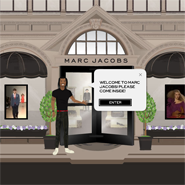- About
- Subscribe Now
- New York,
June 9, 2015

 Marc Jacobs Web site circa 2010
Marc Jacobs Web site circa 2010
MONTE-CARLO, Monaco - Only the United States and China will account for more sales in the luxury industry than collective ecommerce by 2025, according to a McKinsey analyst at the Financial Times' Business of Luxury Summit June 8.
Back in 2009, McKinsey had capped its ecommerce prediction at 2 percent of sales, or $4 billion, for 2015. The actual figure is around 6 percent, or $14 billion, and the research firm has accordingly reassessed its view of digital channels, anticipating robust growth for the next decade and beyond.
"Luxury shoppers are very digital, they are much more mobile digital than the rest of the population," said Nathalie Remy, partner at McKinsey & Company, Paris.
"Brands have to be everywhere, but you have to manage, make sure you're consistent," she said.
New wave
Ecommerce has grown at about 27 percent per year since 2009, four times the rate of offline sales, and McKinsey sees no reason why this rate would stop especially when smartphone penetration is increasing and consumers become more comfortable shopping online.
The average amount of luxury sales generated by ecommerce is six percent, but certain countries are far ahead of the curve.
For instance, ecommerce in Britain accounts for about 11 percent of luxury sales. Brazil and China are two other leaders, and China in particular could be well ahead of the pack since no indisputable measurements exist and the country has a large grey market.
Surprisingly, the highly digital culture of South Korea is average when it comes to ecommerce size. The U.S., Japan and Italy are also middle of the pack.
Fendi's Korean Web site
Ecommerce also varies when looking at the caliber of luxury involved. Affordable luxury generates eight percent of sales through ecommerce, compared to the 3.5 percent of extreme luxury.
Regardless of whether or not a sale will occur online, brands have to actively cater to consumers wherever they are.
Ninety-five percent of luxury buyers are mobile-equipped and two out of three use social media on a weekly basis. The more touchpoints that a brand can engage a consumer with, the better chance a sale will occur or loyalty will increase.
Barney's iPhone app
Luxury shoppers usually carry around five brands in their minds when browsing. The goal of a brand is to enter this elite club and then distinguish itself through a variety of tactics.
Knowing the customer
The barriers to high-level personalization are daunting, but retailers know that the land of relevance is where ROI salvation lies, according to a new report by L2 and Monetate.
Excellent customization entails translating the knowledge and adaptability of a personal shopper to the digital sphere, approximating “organic discretion” in a way that increases conversion. Econsultancy notes that 4 percent of retailers believe their Web sites are “very personalized” and L2 lists a few reasons for this discrepancy between aspiration and actuality: a lack of “management buy-in, technical upskilling and de-siloing of data across channels," (see story).
As brands more adeptly customize offers, the bar for getting into a consumer's "initial consideration set" will only get more challenging.
"In luxury, the initial consideration set is of paramount importance," Ms. Remy said.
Final Take
Joe McCarthy, staff reporter on Luxury Daily, New York
Share your thoughts. Click here